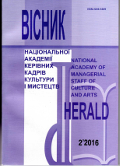FILM MUSIC IN THE WORKS OF CONTEMPORARY UKRAINIAN COMPOSERS
DOI:
https://doi.org/10.32461/2226-3209.2.2016.138518Keywords:
film music, composer, cinema, contemporary culture, music cultureAbstract
The purpose of the article. The research is related to the study of film music of contemporary Ukrainian com-posers. It is a specific genre layer in Ukrainian music culture of today. The author tries to define the problem field of cultural studies of film music of Ukrainian composers and identify some aspects of its understanding (film music as a sound reality of culture, communicative function of music and sound image, etc.). Research methodology lies in the use of comparative methodological principles as well as system and musical-historical methods. The above methodological approach allows to study the applied (by its origin) composing sphere in perspective of representation of contemporary culture and reveal national and cultural identity of film music of Ukrainian composers. The scientific novelty of this study consists in the expansion of notions of the “secondary” field of Ukrainian composers’ works, which is a significant part of our culture and often reflects the major trends of its development. "Music for Films" is a constant of the works of Ukrainian authors, but this issue has not yet become the subject of a special scientific discussion. Conclusions. Film music of Ukrainian composers of the second half of the XX century and today represents a specific phenomenon, characterized by heterogeneity of functional and stylistic manifestations. If, in some cases, music created for a film, is only a special case of manifestation of the creative talent of the composer (as Boris Liatoshynsky, Miroslav Skoryk, Valentin Silvestrov), in others – we are dealing with real experts in this area, whose works in their bulk are connected to the "production" of music for films (Vladimir Guba, Oleg Kiva).
Downloads
Published
Issue
Section
License
Authors who publish with this journal agree to the following terms:
1. Authors retain copyright and grant the journal right of first publication with the work simultaneously licensed under a Creative Commons Attribution License that allows others to share the work with an acknowledgement of the work's authorship and initial publication in this journal.
2. Authors are able to enter into separate, additional contractual arrangements for the non-exclusive distribution of the journal's published version of the work (e.g., post it to an institutional repository or publish it in a book), with an acknowledgement of its initial publication in this journal.
3. Authors are permitted and encouraged to post their work online (e.g., in institutional repositories or on their website) prior to and during the submission process, as it can lead to productive exchanges, as well as earlier and greater citation of published work (See The Effect of Open Access).


